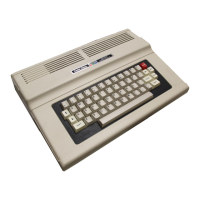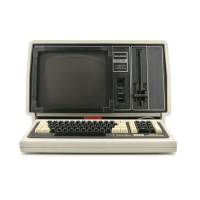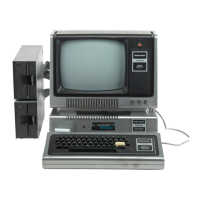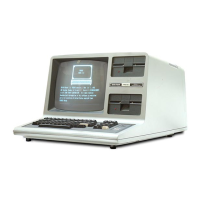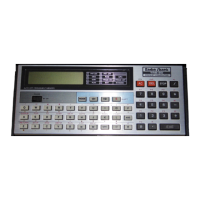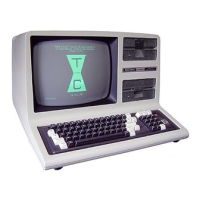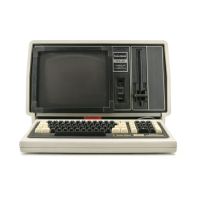FAULT ISOLATION
Problems with
the TRS-80
Color Computer may
be divided
into two
major
categories, I/O
problems
and "dead" computer
problems.
If the
computer
will display the sign-on message,
then the
Color
Computer
Diagnostic
ROM
may be used to
isolate the
section
of the
computer that is bad. If,
however,
the computer
displays
garbage on the TV
screen, then one of
the
major logic
functions has
failed.
A
"dead"
computer
(garbage on the display or no display)
indicates a
major
malfunction of the machine. In
this
case,
the
first thing
to
check is
the power
supply voltage levels. These
may be checked at
the
following points.
+
5 volts-
Test Point 12
-
5
volts
—
Test Point
1
1
+12
volts
-Test Point
9
-
12 volts
-Test Point 10
Ground
—
Test Point 3
Or if you are
having problems
finding
these test
points,
check
the voltages
on one of the RAM
chips
(U20
-
U27).
Pin 1
=
-
5 volts (minus
five)
Pin
8
=
+12
volts
Pin 9
=
+5 volts
If one of the power supply voltages is
off
by
more than
5%,
determine if the
fault
is
due to a
failure within the power
supply or to
another section affecting the power
supply. Refer
to
the Power Supply
section for possible causes
of
the
problem
and tips on how
correct it.
bus. Remove
the ground
plane
and
carefully look at the insula-
tor and the PC Board. It is possible that one of the
IC
leads
has punctured the insulator and is
shorting out.
If
the
compu-
ter operates
without
the ground plane, then trim the excess
leads on
the
bottom of the board.
Make sure you don't leave
any
loose material on the bottom of the
board
when you
replace the ground plane.
If the
computer still
fails to operate after removing the
ground
shield,
you will need to
start
a
methodical checking process.
First, make certain
that the CPU
(U1)
is running
by
using an
oscilloscope to look
at some of the address
lines (pins
8
-
23)
and the data
lines (pins
24
-
31).
They should
normally be
changing
states fairly fast.
If they are not changing at
all, then
one
of the control or clock
signals to the CPU is wrong.
Pins
34
and 35
of
U1
should have
a 0.89
MHz clock input to
the CPU
(U1).
Pins
2,
3, 4, 40,
and 37 should all
be high.
Pin 39
should be low.
If
the CPU is
running then there is some short or open
on the
address or
data
bus. Check to make
certain that all of the
sockets
are properly soldered into the board. It is possible
that
one of the
pins on
a
socket has been bent under. Also check
for any defect on the board
such as a solder short or a broken
etch.
DIAGNOSTIC NOTES
It is possible that
the Diagnostic test may
designate a part
of
the circuit that
is
not
the faulty part. If
the designated
part
does not
seem to be causing
the problem, the following
notes
may help.
If all
of the
voltages are
correct but there is no display what-
soever on the TV screen, a
video problem is evident.
Refer
to
the Video Interface
section for hints on fixing this problem.
If all of the voltages
are
at
the proper
level but you still have
a
screen full of garbage,
then you
should try chip
substitution.
Try replacing the
following chips.
U20
-
U27
Dynamic RAM chips
U10
MC6883
Dynamic
RAM
controller
U1
MC6809E CPU chip
U4andU8
MC6821 PIA
U3
.MCM68A364 ROM
Make
sure
you replace the RAM chips
with
the same size
(4K,
1 6K, or 32K) as the original chips.
If the computer still displays
garbage after the chip substitu-
tion, the most likely problem is a short
on the
address or data
A
video problem is usually caused by
U7
(MC6847),
however,
a
video failure may also be
caused
by U10 (MC6883).
The chip
U10
could
also be the
cause of
a RAM
problem.
A
RAM con-
nected failure of
U10
would be indicated if repeated trys
of
the
RAM
test showed random chip failures, or if
replacing the
indicated RAM chip does not
fix
the
problem.
VIDEO
INTERFACE
The video interface
is composed of four primary parts U6,
U7, U 12,
and
U5.
Also
U
10
is
used to
provide the video
address
lines to
the RAM. The most
likely source of a problem
is
U7
(MC6847).
However, it
is
always a good
idea to isolate the
source of a
problem before
trying
to
desolder chips.
If the problem is
no picture or a distorted picture, then a
new switch box
and cable should be tried. If
you
still do
not
have a picture,
then use your oscilloscope to look at
U7,
pin
28. You should have a video
signal
at
this point. (Refer to
the Video Interface
section
of the Theory
of Operation
for
an
example of what
this signal should look like.)
If you do not
44
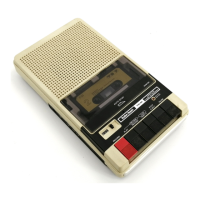
